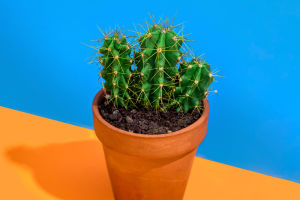Hey, Lyykers! Ever wondered why succulents have become everyone's favorite plant? It's not just their cute, chubby leaves or their low-maintenance vibe—these little guys are seriously fascinating!
Let's explore how to grow these amazing plants and keep them thriving, along with some fun facts that might just surprise you! Ready to get your hands dirty? Let's go!
1. Choosing the Right Soil
Well-Draining Mix: Succulents hate sitting in waterlogged soil. A well-draining soil mix is essential to prevent root rot. You can buy a premixed succulent or cactus soil or make your own by mixing equal parts of potting soil, coarse sand, and perlite.
Container Matters: Use containers with drainage holes. Terracotta pots are an excellent choice for succulents because they promote quicker soil drying, helping prevent overwatering issues.
2. Watering Techniques
Soak and Dry Method: Water your succulents deeply, allowing the water to soak through the soil until it drains out of the bottom. Allow the soil to dry out thoroughly between waterings, as overwatering is the most frequent error in succulent care.
Frequency: Generally, succulents need to be watered once every 2 weeks in the growing season (spring and summer) and less frequently during their dormant period (fall and winter).
3. Light Requirements
Sunlight: Most succulents love bright, indirect sunlight. Place them near a south or east-facing window where they can get around 6 hours of light daily.
Avoid Direct Harsh Sun: While some succulents can tolerate direct sunlight, too much can cause sunburn, especially in hot climates. If you notice your succulents turning brown or pale, move them to a slightly shaded area.
4. Temperature and Humidity
Optimal Temperature: Succulents prefer a temperature range between 60°F and 80°F (15°C to 27°C). They can handle cooler temperatures at night, but frost can be deadly.
Low Humidity: Succulents thrive in dry air, so there's no need to mist them. High humidity can promote rot, so it's best to keep them in a well-ventilated area.
5. Fertilization
Feeding Time: Succulents don't need much fertilizer, but they can benefit from light feeding during the growing season. Apply a balanced, water-soluble fertilizer once a month, diluted to half strength for optimal plant health.
Avoid Overfeeding: Too much fertilizer can lead to leggy growth and weaken the plant, so it's best to err on the side of caution.
Precautions to Keep Your Succulents Happy
1. Avoid Overwatering
Overwatering is the number one killer of succulents. Their roots are adapted to absorb water quickly and then dry out. Make sure the soil is fully dry before watering again to prevent overwatering and root rot.
2. Watch for Pests
Succulents are generally resistant to pests but can occasionally attract mealybugs, spider mites, or aphids. If you spot pests, isolate the affected plant and treat it with neem oil or a mild insecticidal soap.
3. Repotting as Needed
Repot your succulents every 2 years to refresh the soil and provide room for growth. Spring is the best time to do this, as the plants are emerging from their dormant period.
4. Handle with Care
Succulents have delicate leaves that can easily break off, so handle them gently when moving or repotting. If a leaf does fall off, you can propagate it by placing it on top of the soil and waiting for roots to develop.
Fun Facts About Succulents
Long Lifespan: Some succulents, like the Jade Plant, can live for decades, becoming a cherished part of your home.
Ancient Origins: Succulents have been around for millions of years, adapting to survive in some of the world's harshest environments.
Cultivating succulents is an exciting and rewarding experience. By following these tips, you'll be well on your way to growing healthy, beautiful plants that can brighten up any space. So, what are you waiting for? Grab your favorite pot, mix up some soil, and let's get planting! Your succulents will thank you for it!


